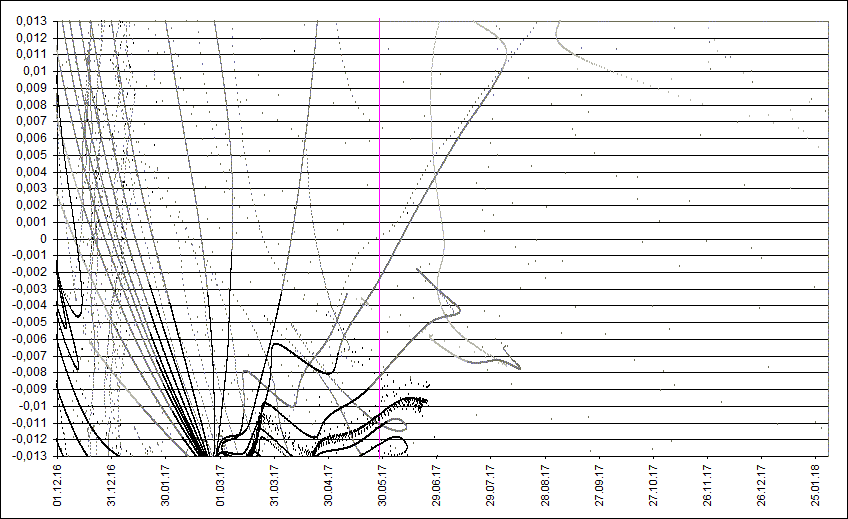Tau-Herculids: prediction of activity
to the list of predictions

Fig. 1. Space-temporal projection of tau-Herculid trails parts onto their minimal distance passages dirung the period (correspondence between colours of the particles and their ejection velocities can be seen here).
In 2017 the comet 73P/Schwassmann-Wachmann 3 passes its perihelion, and its orbit lies at -0.01399 AU from the Earth orbit. However, that vast majority of the comet trails intersects the Earth orbit several months prior to the shower maximum, as seen on the Fig. 1, and only one dense trails passes relatively close to the Earth. It is 1941 trail, the parameters of encounter are: rD-rE=-0.00207 AU, fM(fMD)=-3.709, Vej=-15.18 m/s, time of maximum is May 30 at 17:42 UT, theoretical radiant: RA=211.2°, Dec=+29.7°, V=17 km/s.
Such parameters allow to hope only for separate meteors at best, as the trail still passes quite far from the Earth and the encounter is with part of the trail composed of particles with negative ejection velocoties, so the radiation pressure "blows" smaller particles away. However, it also means that if any meteors would appear, they should be quite bright, as only relatively large particles could remain in this part of the trail. So far we consider this case as a "boundary" one and while activity could easily be absent at all, we recommend to check what will happen.
Such parameters allow to hope only for separate meteors at best, as the trail still passes quite far from the Earth and the encounter is with part of the trail composed of particles with negative ejection velocoties, so the radiation pressure "blows" smaller particles away. However, it also means that if any meteors would appear, they should be quite bright, as only relatively large particles could remain in this part of the trail. So far we consider this case as a "boundary" one and while activity could easily be absent at all, we recommend to check what will happen.

Fig. 3. The Earth as seen from coming tau-Herculid meteors (RA=211.2°, Dec=+29.7°) during the expected maximum time of outburst from 1941 trail on 30 May at 17:42 UT.
As shown on the Fig. 2, in case the activity occurs at the denoted time, it should be seen well in the southern and central part of Eurasia, as well as in eastern Africa. The waxing crescent Moon in the phase of 31% could create some troubles, especially in the first part of night, however its altitude will be not very high, especially in the southern hemispere. Also it will be positioned far from the radiant on the sky, so its influence will be not very large.
Ссылки
1. Программа С. Шанова и С. Дубровского "Comet's dust 2.0". [Использована для расчета орбитальной эволюции метеорных частиц]
2. Lyytinen E, van Flandern T. "Predicting the strength of Leonid outbursts", 2000, Icarus, P. 158-160.
3. Казуо Киносита, http://www9.ocn.ne.jp/~comet/index.html [Орбитальные элементы кометы 73P/Schwassmann-Wachmann 3.]
4. Jenniskens P. Meteor showers and their parent comets, 2006, 780 p.
Ссылки
1. Программа С. Шанова и С. Дубровского "Comet's dust 2.0". [Использована для расчета орбитальной эволюции метеорных частиц]
2. Lyytinen E, van Flandern T. "Predicting the strength of Leonid outbursts", 2000, Icarus, P. 158-160.
3. Казуо Киносита, http://www9.ocn.ne.jp/~comet/index.html [Орбитальные элементы кометы 73P/Schwassmann-Wachmann 3.]
4. Jenniskens P. Meteor showers and their parent comets, 2006, 780 p.